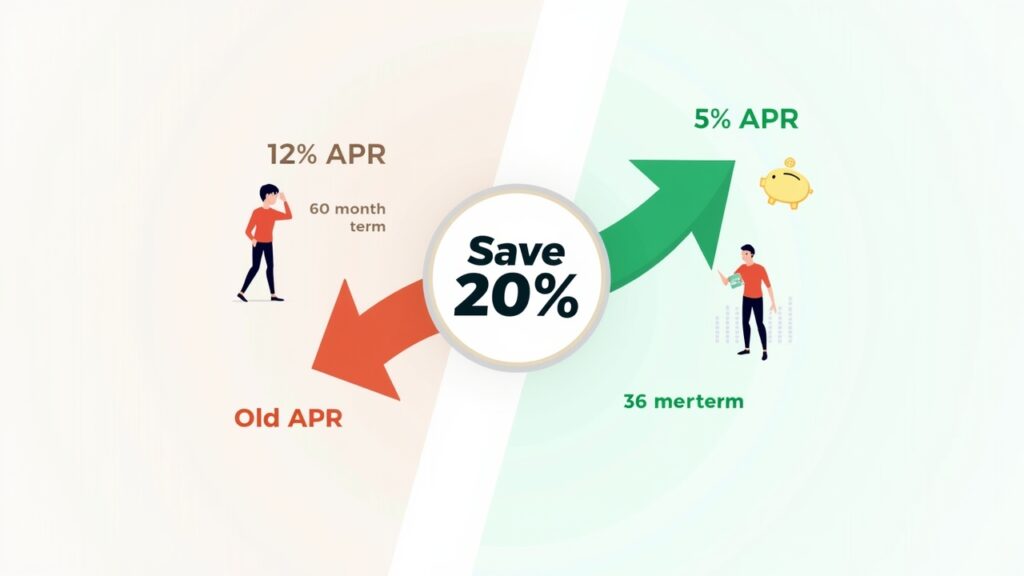Advertisements
Did you know that the average American could save over $100 a month by refinancing their car loan? Yeah, I didn’t believe it either until I actually did it! When I first heard about car loan refinancing, I thought it was just another financial gimmick.
Boy, was I wrong. Let me tell you about the time I nearly cried tears of joy at my kitchen table.
It was 2019, and I was drowning in a 12% interest rate on my Honda Civic. My buddy Dave mentioned he’d just refinanced his truck loan, and I figured, why not give it a shot? Three weeks later, I was staring at my new loan docs with a 4.5% rate, saving me literally thousands over the life of the loan!
What Even Is Car Loan Refinancing?

Okay, so here’s the deal. Car loan refinancing is basically when you get a new loan to pay off your existing auto loan. Simple as that.
Think of it like switching phone carriers for a better deal. You’re not getting a new car – you’re just getting better terms on the money you already owe. The new lender pays off your old loan, and boom, you start making payments to them instead.
I remember being so confused about this at first. My sister had to explain it to me three times before it clicked! The whole point is to get either a lower interest rate, smaller monthly payments, or sometimes both if you’re lucky.
When Should You Actually Consider Refinancing?
Not gonna lie, timing is everything with this stuff. Here’s what I learned the hard way:
- Your credit score has improved since you got the original loan (mine jumped 80 points in two years!)
- Interest rates have dropped overall – check Federal Reserve data for current rates
- You’ve been making payments for at least 6-12 months
- Your car isn’t super old (most lenders won’t touch cars over 10 years)
- You still owe more than $5,000 (otherwise it ain’t worth the hassle)
I tried refinancing after just 3 months with my original loan. Big mistake. Got rejected faster than my prom date proposal!
The Step-by-Step Process That Actually Works
Alright, here’s exactly how I did it, mistakes and all:
Step 1: Check Your Current Situation
First things first – dig out that loan paperwork. I spent two hours looking for mine before remembering I’d stuffed it in my filing cabinet. You need to know your current interest rate, remaining balance, and monthly payment.
Step 2: Shop Around Like Crazy
This is where most people mess up. Don’t just go with the first offer! I checked with five different lenders:
- My credit union (they had the best rate)
- Online lenders like LightStream
- Traditional banks
- Even my insurance company offers auto loans
Pro tip: Do all your rate shopping within 14 days. Credit bureaus count multiple auto loan inquiries as one if they’re close together.
Step 3: Crunch the Numbers
Here’s where I almost made a huge mistake. The monthly payment isn’t everything! You gotta look at the total cost over the life of the loan. I nearly went with a loan that had lower monthly payments but would’ve cost me $2,000 more in the long run.
Watch Out for These Sneaky Pitfalls
Man, there’s some stuff they don’t tell you upfront. Like prepayment penalties – yeah, that’s a thing! My original loan had a $300 fee if I paid it off early.
Also, some lenders try to sneak in extended warranties or gap insurance. Just say no unless you actually need it. They tried to sell me gap insurance on a car I’d already owned for two years!
Another thing that caught me off guard was the title transfer process. In some states, it’s a real pain. Took me three trips to the DMV because I kept forgetting documents. Save yourself the headache and call ahead to ask what you need.
Real Numbers from My Experience

Let me break down my actual savings:
- Original loan: $18,000 at 12% for 60 months = $400/month
- Refinanced loan: $15,500 at 4.5% for 48 months = $353/month
- Total savings: About $3,100 over the life of the loan!
Sure, I extended my loan by a few months, but the interest savings was totally worth it. Plus, that extra $47 a month really helped when my water heater exploded last year. (Why do those things always break at the worst times?)
Your Turn to Save Some Serious Cash
Look, I’m not saying refinancing is right for everyone. But if you’re sitting there with a high interest rate and your credit’s improved, you’d be crazy not to at least check your options.
The worst they can say is no, right? And the best case scenario – you could save thousands like I did. Just remember to read the fine print, avoid the sketchy add-ons, and don’t let them pressure you into anything.
Want more money-saving tips that actually work? Check out other practical finance guides at The Clear Cents – we keep it real and skip the confusing jargon!



